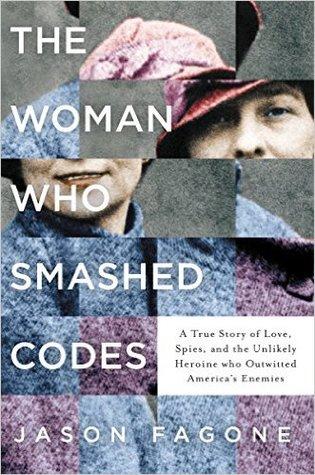Book: The Woman Who Smashed Codes: A True Story of Love, Spies, and the Unlikely Heroine Who Outwitted America's Enemies by Jason Fagone
Genre: History
Publisher: Dey St.
Publication date: 2017
Pages: 444
Source: ebook and hardback borrowed from the library
 Summary: Elizebeth Smith started off life as a very ordinary early 20th century woman. The only thing unusual about her was the way that she spelled her first name.
Summary: Elizebeth Smith started off life as a very ordinary early 20th century woman. The only thing unusual about her was the way that she spelled her first name.
Her first little rebellion from her Quaker family was to insist on going to college, even if she had to pay her own way. She worked as a seamstress while studying Greek and English literature. At graduation, she took work in one of the few fields open to women, education.
Her second little rebellion was to leave that job and seek her fortune in Chicago. By sheer chance, she found herself in the sights of George Fabyan. George Fabyan was fabulously wealthy. William Randolph Hearst built a castle near enough to Hollywood to attract actors. Fabyan took a different route. He built a campus called Riverbank in Illinois where he lured scholars and scientists with high salaries and interesting projects - some more credible than others.
Fabyan recruited young Elizebeth Smith for one of his less credible projects - examining Shakespeare's First Folio for evidence of a cipher placed there by Francis Bacon to prove that Bacon was the true author.
That project proved fruitless, but it set Elizebeth Smith on the path that she would pursue for the rest of her professional life. She met her husband William Friedman and the two of them were major figures in American codebreaking starting in World War I.
For the first eight months of the war, as incredible as it sounds, William and Elizebeth, and their team at Riverbank, did all of the codebreaking for every part of the U.S. government: for the State Department, the War Department (army), the navy, and the Department of Justice. And the broader scientific insights of the Riverbank Publications emerged directly from these day-to-day puzzles solved under wartime pressure. The pair would solve a cryptogram and realize they may have stumbled onto some more general method. Then they would test the method on additional examples, trying to see where it broke, what its limits were, aiming to strengthen a one-time solution into a universal principle and to share that knowledge with others. (p. 83)
After the war, Elizebeth expected to disappear into motherhood while writing children's books. Instead, she became the most famous codebreaker in America. She testified in high-profile trials against rum runners during Prohibition, having cracked their codes for the Coast Guard. She left the limelight as World War II approached, doing secretive work that exposed the German spy network in South America. Meanwhile, her husband organized the army's cryptanalysis efforts, eventually ending up at Arlington Hall where many civilian women took jobs as Code Girls.
Thoughts: The Woman Who Smashed Codes is a biography of a remarkable, but largely forgotten, woman. It's also a remarkable history of an aspect of governance, commerce, and war-making that is usually wrapped in veils from the public - the need for secrets and the various ways of hiding them and of revealing them.
Appeal: This is my third review of books about codes and codebreaking this month. My NaNoWriMo project, this year, is about women codebreakers in World War II, so I queued up my reviews for Mondays this month. Of all the books that I read or consulted during my preparation, The Woman Who Smashed Codes is the most enjoyable as a good read. You'll love it if you like reading the history of the first half of the 20th century or women's history or the history of ciphers and codes.
Have you read this book? What did you think?


About Joy Weese Moll
a librarian writing about books
